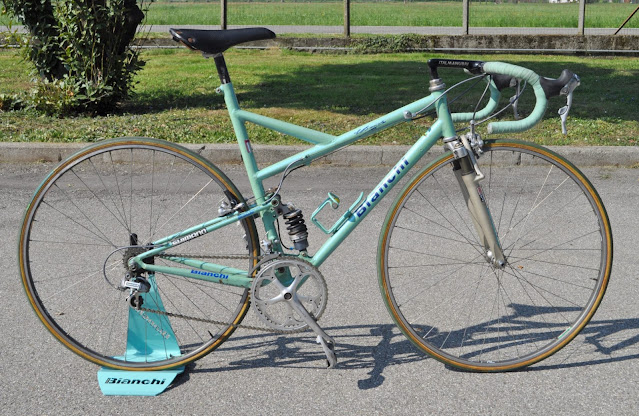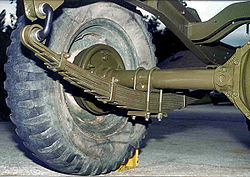It won't be surprising to know that suspension on bicycles goes back to the very inception of the machine.
Here's a beautiful replica of one of the better known bikes of the era before pneumatic tires, the 1888 Whippet, re-made by Paul Brodie:

There're about three inches of vertical travel in the back, and another three inches in the front through that scissor linkage, but unlike contemporary suspension systems where the front and rear wheels move independently of each other and the frame, the Whippet connects the front and rear wheel to the same sub-frame. The concept is the same as and axle and leaf spring on an old truck, except on the bike the wheels are sideways.
The sub-frame with the wheels moves up and down with bumps while the top frame with the rider stays stationary. The advantage of this suspension system to other types of its day (like super-springy saddles) is that the bottom bracket connects to the saddle in a solid line, so that on really bumpy roads where the suspension works hard, the distance from the saddle to the cranks doesn't change, maintaining pedaling efficiency and comfort.
The downside of this suspension system, in fact the downside of all suspension, is that it causes the rider to bob up and down a lot. The goal of bike riding is to go forward, in a horizontal line with the road, but when there's a lot of suspension bob part of the forward moving energy is wasted on vertical movement, thus making the ride slower and inefficient. On a mountain bike, while going over roots and rocks, a little mechanical energy wasted on vertical travel isn't a big drawback because shock absorbers greatly increase the comfort of the rider, allowing him or her to apply more energy to pedaling for longer durations. But on the road, where the greatest obstacle is an occasional 2-inch-deep pothole, a springy suspension causes more problems than it fixes.
After John Lloyd Dunlop popularized the pneumatic (air filled) bike tire, spring-type suspensions fell out of favor. A modern bike tire responds to bumps faster and more efficiently than any of the more mechanical systems because the air filled tire conforms around bumps and fills up dips without any bobbing, moving parts, or extra weight – and they're easily tunable to road conditions by adding or removing air pressure. The only downside of the pneumatic tire is that as the bumps get bigger, the tire must get bigger to absorb them, and at a certain point the size and weight of the wheel becomes slow and unmanageable.

For seventy years, air-filled tires covered all the shock-absorbing needs of both the casual and the aggressive rider.
But a funny thing happened, starting in the seventies and continuing into today: tires became thinner.
The reason for using a thin tire is that it has less mechanical and aerodynamic drag, relative to bigger tires, and therefore is faster (in controlled conditions, at least). This is sometimes true, and sometimes not true. Really, it depends entirely on the road surface and the weight and riding style of the rider.
But with that said, the 19mm slick tires of the late 70's and early 80's were a bad idea.
I've ridden ultra-skinny tires. They feel fast, but after an hour the road buzz becomes unbearable.
But I'll admit, on a thin-tubed steel racing bike they look hella dope.
So with skinny tires becoming the standard for the last forty years, bicycle designers have tried many, many systems to return comfort to the riding populace without upsetting the skinny-tire fashion.
Here are a few of my favorite full-suspension road bikes throughout time:
 |
| Made in 1994 for the Paris-Roubaix, this bad daddy uses a multi-link rear suspension borrowed from Bianchi's XC line. |
 |
| And this Bianchi from 1996 is made entirely out of Titanium, which is 3x as springy as steel. |
 |
| I don't care what any of the haters say. Softride bikes are cool. They're also stupid. Sometimes cool things, just like cool people, are stupid. One of the many reasons people hate Softrides is that the saddle bounces up and down, but the pedals don't, so the saddle height is always changing. Put a Girvin Flexstem on there and you're in a world of painful solutions to self-imposed comfort problems. I'd like to add that the chain on this particular image is too long.
From the Pacific brand, which sells to US department stores, comes this cool cucumber. Exhibited at the 2012 Taiwan Bike Show. Not sure if this one made it into production
|
 |
| Moving away from traditional piston-type shocks, we have this prototype from Canyon, which uses elastic materials as springs in the fork and rear triangle. |
Most of these road suspension systems are driven more by marketing than problem-solving. That isn't to say that the Trek Domane, or whatever, isn't a good bike – I've ridden it, it's a fine machine. All suspended road bikes are probably comfortable over the cobbles, but they all have drawbacks – not the least of which being an inflated MSRP. There's a growing body of research that fat, compliant tires are, in fact, faster than their skinny equivalents, even on smooth roads while riding solo into a headwind. This is because high-frequency vibrations have been linked to fatigue, skin abrasions (butt rub), muscle soreness, and in extreme cases: impotency, and in very extreme cases: bone degeneration. Big tires absorb all bumps and vibrations, but suspension systems are designed to counter only big, shocking jolts – that way they don't bob during normal riding.
The problem for bike makers is that – with the exception of +plus bikes – big, dopey tires don't sell; mechanical suspension and wacky engineering does.
My main piece of advice regarding bicycle design is to remember than Cycling is a sport, but Bicycles are an industry. What the rider needs or wants is not always synonymous with the business's goals. Discerning value from hype is difficult, and subjective, but with education the distinctions become more clear.
For further reading, I suggest Mike Burrow's excellent treaty on bicycle design, called, fittingly, Bicycle Design.
And here's his Facebook: https://www.facebook.com/Mike-Burrows-Bicycle-Design-128890030472474/
And while you're there, go to my Facebook: https://www.facebook.com/bikeblogordie/
.
.
.
.
P.S. Though not specifically a road bike, this funky "gravel grinder" from Niner picks up where Bianchi left off in the 90's:
 |
| I want to point out the little fender on the back that protects the suspension linkage and bottom bracket from tire-spray. That's good design right there. |
Like this article? Well I have a whole series on how to make a frame and fork that you might enjoy. Want to learn more about bicycle history? I got some good stuff here too.





Wonderful post about suspension of bikes and you also specifies the history of suspension that I appreciate personally. It is must that bike has a suspension that give full comfort to the rider.
ReplyDeleteThanks Admin to deliver a nice post of the Suspension of a bike. Also you attached the several image of bike suspension which is wonderful. It will help to gain knowledge about suspension. https://www.hybridbikers.com/takara-sugiyama-flat-bar-fixie-bike-review/
ReplyDeleteYour site is truly cool and this is an incredible rousing article. Much thanks to you to such an extent. soil testing
ReplyDeletea monkey kidnapped me
ReplyDeletesurprising CourtFarm to know that suspension on bicycles
ReplyDelete